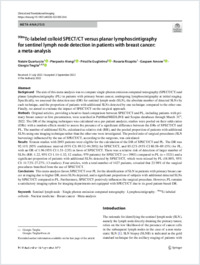99mTc‑labeled colloid SPECT/CT versus planar lymphoscintigraphy for sentinel lymph node detection in patients with breast cancer
: a meta‑analysis
- Quartuccio, Natale ORCID Nuclear Medicine Unit, A.R.N.A.S. Ospedali Civico, Di Cristina e Benfratelli, Palermo, Italy
- Alongi, Pierpaolo ORCID Nuclear Medicine Unit, A.R.N.A.S. Ospedali Civico, Di Cristina e Benfratelli, Palermo, Italy
- Guglielmo, Priscilla ORCID Nuclear Medicine Unit, IOV-IRCCS, Castelfranco Veneto, TV, Italy
- Ricapito, Rosaria Nuclear Medicine Unit, A.R.N.A.S. Ospedali Civico, Di Cristina e Benfratelli, Palermo, Italy
- Arnone, Gaspare ORCID Nuclear Medicine Unit, A.R.N.A.S. Ospedali Civico, Di Cristina e Benfratelli, Palermo, Italy
- Treglia, Giorgio ORCID Imaging Institute of Southern Switzerland, Ente Ospedaliero Cantonale, Bellinzona, Switzerland - Faculty of Biology and Medicine, University of Lausanne, Lausanne, Switzerland - Faculty of Biomedical Sciences, Università della Svizzera italiana, Switzerland
- 2022
Published in:
- Clinical and translational imaging . - 2023, vol. 11, p. 587–597
Sentinel lymph node
Single photon emission computed tomography
Lymphoscintigraphy
99mTc-labeled colloids
Nuclear medicine
Breast cancer
Meta-analysis
English
Background : The aim of this meta-analysis was to compare single-photon emission computed tomography (SPECT/CT) and planar lymphoscintigraphy (PL) in patients with primary breast cancer, undergoing lymphoscintigraphy at initial staging. Specifcally, we assessed the detection rate (DR) for sentinel lymph node (SLN), the absolute number of detected SLNs by each technique, and the proportion of patients with additional SLNs detected by one technique compared to the other one. Finally, we aimed to evaluate the impact of SPECT/CT on the surgical approach. Methods : Original articles, providing a head-to-head comparison between SPECT/CT and PL, including patients with primary breast cancer at frst presentation, were searched in PubMed/MEDLINE and Scopus databases through March 31st, 2022. The DR of the imaging techniques was calculated on a per-patient analysis; studies were pooled on their odds ratios (ORs) with a random-efects model to assess the presence of a signifcant diference between the DRs of SPECT/CT and PL. The number of additional SLNs, calculated as relative risk (RR), and the pooled proportion of patients with additional SLNs using one imaging technique rather than the other one were investigated. The pooled ratio of surgical procedures (SLN harvesting) infuenced by the use of SPECT/CT, according to the surgeons, was calculated. Results: Sixteen studies with 2693 patients were eligible for the calculation of the DR of SPECT/CT and PL. The DR was 92.11% [95% confdence interval (95% CI) 89.32–94.50%] for SPECT/CT, and 85.12% (95% CI 80.58–89.15%) for PL, with an OR of 1.96 (95% CI 1.51–2.55) in favor of SPECT/CT. There was a relative risk of detection of larger number of SLNs (RR: 1.22, 95% CI 1.14–1.32; 12 studies; 979 patients) for SPECT/CT (n=3983) compared to PL (n=3321) and a signifcant proportion of patients with additional SLNs detected by SPECT/CT, which were missed by PL (18.88%, 95% CI: 11.72%-27.27%; 13 studies). Four articles, with a total number of 1427 patients, revealed that 23.98% of the surgical procedures benefted from the use of SPECT/CT. Conclusions: This meta-analysis favors SPECT/CT over PL for the identifcation of SLN in patients with primary breast cancer at staging due to higher DR, more SLNs depicted, and a signifcant proportion of subjects with additional detected SLNs by SPECT/CT compared to PL. Furthermore, SPECT/CT positively infuences the surgical procedure. However, PL remains a satisfactory imaging option for imaging departments not equipped with SPECT/CT due to its good patient-based DR.
- Collections
- Language
-
- English
- Classification
- Medicine
- License
- Open access status
- hybrid
- Identifiers
-
- DOI 10.1007/s40336-022-00524-6
- ARK ark:/12658/srd1325747
- Persistent URL
- https://n2t.net/ark:/12658/srd1325747
Statistics
Document views: 130
File downloads:
- Treglia_2022_Spri_cti: 134
